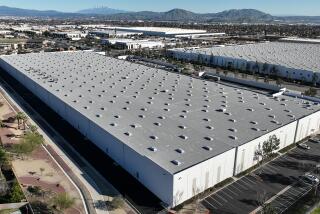California has largest number of minorities near hazardous waste
California has the nation’s highest concentration of minorities living near hazardous waste facilities, according to a newly released study. Greater Los Angeles tops the nation with 1.2 million people living less than two miles from 17 such facilities, and 91% of them, or 1.1 million, are minorities. Statewide the figure was 81%.
The study, conducted by researchers at four universities for the United Church of Christ, examined census data for neighborhoods adjacent to 413 facilities nationwide that process or store hazardous chemical waste produced by refineries, metal plating shops, drycleaners and battery recyclers, among others.
Though about one-third of U.S. residents are nonwhite, more than half of the people living near such facilities were Latino, African American or Asian American, according to the report.
The cause is simple, said Robert Bullard, a sociologist at Clark Atlanta University in Georgia and lead author of the study, which updates a landmark report from two decades ago. “The most potent predictor of where these facilities are sited is not how much income you have; it’s race.... You don’t have many of these facilities in West Los Angeles, and you don’t have many minorities in West Los Angeles either.... You’ve got both in Vernon and surrounding neighborhoods.”
L.A. ranked first among major urban areas with the most people living near hazardous waste facilities. Oakland and Orange County placed fifth and sixth, respectively, with hazardous sites in Santa Ana and other minority neighborhoods.
The study also found that hazardous waste facilities were often clustered with other potentially dangerous industries, and that the rate of minority residents in areas with multiple hazards was even higher.
“There’s a piling on effect.... You get the landfill because you’ve already got the incinerator, the paint manufacturer, the chemical plant,” Bullard said. “These neighborhoods become basically sacrifice zones.”
Sue Briggum, vice president of federal public affairs for Waste Management, which operates several of the facilities examined in the study, including a landfill in Kettleman City, Calif., said the hazardous waste industry is heavily regulated for safety and provides an important recycling service.
Briggum, who served on a national environmental justice task force several years ago, acknowledged the problems highlighted by the study. “There’s no disputing the facts,” she said. But, she added, the industry and the U.S. Environmental Protection Agency have done a great deal in recent years to try to reduce emissions, beef up safety and address other concerns in affected neighborhoods.
Although low-income neighborhoods were much more likely to have hazardous waste facilities, some of the areas examined were quite affluent, including one in Seattle that is predominantly Asian, said study coauthor Robin Saha, a sociologist with the University of Montana.
Bullard said the saddest case researchers studied was in rural Dickson County, Tenn., an almost entirely white area in which every industrial waste facility in the 300,000-acre county was built next to a 150-acre farm owned by a black family.
The study took EPA officials to task for failing to implement an executive order by President Clinton requiring that environmental justice issues and the cumulative effects of clustering such facilities in some neighborhoods be a mandatory part of environmental reviews.
Rep. Hilda Solis (D-El Monte) introduced legislation in February designed to achieve the same goals.
“This legislation is a critical first step to achieving real and lasting justice for minority and low-income communities across this country.” Solis said. “Codifying the executive order will empower communities without a voice to join in the fight to protect their health and welfare.”
EPA spokeswoman Jennifer Wood said the agency recognizes “that minority and/or low-income communities frequently may be disproportionately and adversely exposed to environmental harms and risks,” and that the EPA attempts to address environmental justice concerns in its planning and budgeting.
But Bullard said the EPA’s inspector general and the U.S. General Accountability Office have chastised the agency for its handling of environmental justice issues. President Bush’s 2008 budget recommends a 28% cut in funds for such programs, he said
The report follows up on issues originally raised in the 1987 study “Toxic Wastes and Race in the United States,” which is widely considered to have given birth to the environmental justice movement by linking race and income to elevated levels of environmental and industrial risk.
“We think that we’ve gotten so far in civil rights and creating a more equal society,” coauthor Saha said of the new findings. “But when it comes to the environment, to the most basic things -- air and water -- we have a long way to go still.”
*
(BEGIN TEXT OF INFOBOX)
Neighborhoods near hazardous waste sites
A new report lists 10 California metropolitan areas where residents living less than two miles from hazardous waste facilities were disproportionately minorities.
Percent people of color* living in neighborhoods that are:
*--* Metropolitan area Near waste (no. of facilities) facilities Not near Difference L.A./Long Beach (17) 90.9% 65.8% 25.0% Fresno (2) 78.4 58.9 19.6 San Jose (2) 77.1 53.6 23.5 Oakland (6) 76.0 49.2 26.7 Riverside/San Bernardino (4) 70.5 52.4 18.2 Orange County (3) 69.8 46.8 23.0 Vallejo/Fairfield/Napa (2) 59.1 45.4 13.7 Stockton/Lodi (1) 58.3 52.4 6.0 San Francisco (2) 55.6 48.6 7.0 Sacramento (1) 41.9 35.7 6.1
*--*
* Includes Latinos, African Americans, Asians, Pacific Islanders, Native Americans and other minorites.
Sources: United Church of Christ Justice and Witness Ministries, 2000 census
More to Read
Sign up for Essential California
The most important California stories and recommendations in your inbox every morning.
You may occasionally receive promotional content from the Los Angeles Times.










